 |
|

|
 |
TABLE of CONTENTS
 |
District 7 creates videos to help prepare motorists for six-month closure of Hwy 169 Mankato to St. Peter |
By Rebecca Arndt, District 7 public affairs coordinator
|
The Hwy 169 construction project will close the road from April to October 2016 and affect thousands of travelers, from college students and truckers to medical patients and Vikings fans. A series of videos distributed through social media and the Internet is one of many ways District 7 project staff is getting the word out to motorists. |
If a picture is worth a thousand words, then can a video reach 14,000 daily motorists on Hwy 169 between Mankato and St. Peter?
That’s the plan, according to MnDOT District 7/Mankato staff. The district recently developed three one-minute videos for distribution via social media and the Internet that will highlight the work necessary for the flood mitigation project, the plan to accomplish it in one year and the required detour to get it done.
You can view all three videos at www.mndot.gov/fix169flood and on MnDOT’s Facebook page.
Use of video to prepare commuters for the impacts of a construction project is a first for MnDOT District 7. The construction project will close Hwy 169 from April to October this year and affect thousands of travelers, from college students and truckers to medical patients and Vikings fans.
Metro District in January kicked off a similar series of videos for the Interstate 694 project in the north Twin Cities metro area.
“The goal of these videos is to get people to plan their route before the detour is on in order to avoid confusion and avoid crashes. This tool gets important information into busy people’s hands,” said Peter Harff, District 7 project manager.
A current detour map and expected timeline can be found at www.mndot.gov/fix169flood. Interested individuals can also sign up for e-mail updates throughout the project.
The $30 million project includes raising the grade in four flood-prone areas (Hiniker Mill, 7-mile Creek, Old River Road, and State Hospital) to elevate the road above the 100-year flood level; resurfacing six miles of highway to create a smoother road; and adding a median barrier to prevent head-on crashes. The project received a $9.8 million grant from the Economic Development Administration. |
 |
|

|
 |
TABLE of CONTENTS
 |
Several transportation policy initiatives are on 2016 legislative agenda |
Legislators returned to the Capitol March 8 to consider a number of issues important to Minnesotans, including several transportation-related initiatives.
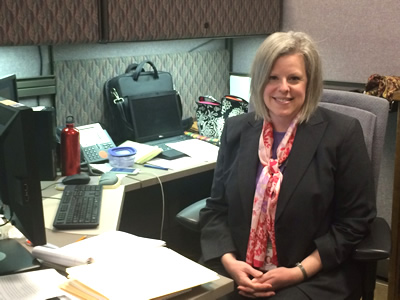
Deanna Belden, Performance, Risk & Investment Analysis director in the Office of Transportation System Management, is the 2016 session legislative liaison for the Office of Government Affairs. She’s located on the fourth floor of Central Office. Photo by Chris Joyce
|
Supplemental budget
Governor Mark Dayton recommends a major investment plan for transportation to fund the estimated $6 billion gap that exists between funding needs and revenues in the next 10 years. The governor proposes addressing the gap through a 6.5 percent gross receipts tax on gasoline, an increase in registration fees, an additional $2 billion in trunk highway bonds over the next 10 years, and through MnDOT efficiencies. These sources will fund roads and bridges at the state, county and municipal level.
In addition, the governor recommends a general fund increase for Greater Minnesota Transit of $10 million per year and a general fund increase for bike and pedestrian infrastructure, including Safe Routes to School, of $2.5 million per year.
For more details about the supplemental budget, see http://mn.gov/governor/issues/budget/.
Capital budget
In even-numbered years, the governor recommends the capital budget to the Legislature. It includes requests for state bond funds and other non-bond funds for various infrastructure projects. The governor recommended a total of $135,624,000 for transportation infrastructure projects this biennium, including to:
-
Construct grade separations at highway-railroad grade crossings along corridors in which oil or other hazardous materials are transported. The funds will be used at priority locations identified in the Crude by Rail Grade Crossing Study. Currently three locations — Moorhead, Coon Rapids and Prairie Island — have plans in place and are eligible for funding.
-
Provide grants to cities to help implement train whistle-free quiet zones as approved by the Federal Railroad Administration.
-
Design, construct and equip replacement of active highway-railroad grade warning devices that have reached the end of their useful life. At a cost of approximately $300,000 per crossing location, these funds could upgrade an estimated 15 locations.
-
Establish a MnDOT Facilities Capital Improvement Program that supports extending the useful life of existing facilities through renovation and expansion to meet current operational needs.
-
Fund the Minnesota Port Development Assistance Program, which supports infrastructure needs of Minnesota’s public ports on the Great Lakes and Inland River Navigation Systems.
-
Provide state match for implementation of passenger rail service, such as the second daily train between St Paul and Chicago, and the Northern Lights Express service to Duluth. Capital improvements include preliminary engineering, design, engineering, environmental analysis and mitigation, land acquisition, and construction. This request would also pay for agency staff costs directly attributable to capital projects.
Policy initiatives
MnDOT is also introducing a number of policy initiatives, including:
- Updating bicycle laws and rules, which were last revised in the 1970s. These laws and rules have obsolete definitions and do not reflect current designs for safe bicycle facilities.
- Amending the Dimler law [Minn. Stat. 171.12, Subd. 6(c)] to include language regarding holders of a commercial driver’s learner permit. Federal regulations require that states show on the commercial driver’s record all convictions for any violation (except parking) in any type of motor vehicle. Noncompliance with federal regulations jeopardizes federal funding.
- Changing the effective date for a provision linking overweight truck permits and vehicle registration.
- Turning jurisdiction of Hwy 225 over to Becker County.
- Revising statutory language to match a change enacted in 2015 regarding the distribution of county state-aid highway funds.
- Specifying that utility relocation costs on Interstate projects are the expense of the utility, as is the case on all other highway projects. This would only apply to new utility installations. Existing utilities on Interstates would continue to be relocated at state expense.
In addition, some policy initiatives discussed in 2015 are re-emerging in 2016, including:
-
Allowing flaggers to report work zone driving violations to law enforcement, who could issue a citation to the motorist within four hours. Similar law exists for school bus drivers in reporting motorists who ignore a school bus stop arm.
-
Allowing contractors to develop project schedules within MnDOT’s project management software, saving time and money.
-
Establishing a state bikeway in memory of Congressman Jim Oberstar. The bikeway would run from St. Paul through Duluth, ending at the Canadian border north of Grand Marais.
-
Establishing a pilot program for five projects using an administrative law judge instead of commissioners to decide eminent domain cases. Currently, three commissioners are appointed by the courts to determine compensation. Using the Office of Administrative Hearings should result in savings of time and money.
For more information on the 2016 legislative session, visit the Government Affairs web page. The site includes weekly reports for the session and legislatively mandated reports. |
 |
|

|
 |
TABLE of CONTENTS
 |
Legislative Auditor makes recommendations for highway project selection
|
|
By Chris Joyce The Minnesota Office of the Legislative Auditor testified before the Joint House & Senate Transportation Committee March 15, reporting on MnDOT’s processes for selecting highway construction projects.
Chief among the auditor’s findings was the assessment that MnDOT’s processes for selecting trunk highway projects are not transparent, although MnDOT “has mostly channeled funding toward projects that meet the department’s priorities.”
The report further notes that “projects chosen through MnDOT’s alternative processes have not always been consistent with departmental priorities, and some have been chosen in an inconsistent and subjective manner,” citing the Corridors of Commerce program.
Among the Legislative Auditor’s six key recommendations for improving MnDOT’s project selection processes are that the agency “increase transparency and fix the Corridors of Commerce selection process.”
Commissioner Charlie Zelle and Mark Gieseke, Office of Transportation System Management director, also testified before the joint committee, responding to the report and to legislators’ questions. They generally agreed with the report’s findings.
“We are pleased that the report affirms the work MnDOT has already done to improve its project selection process over the past several years and since the 2008 audit,” Gieseke said. In particular, he said, MnDOT appreciates the acknowledgment for:
- MnDOT’s nationwide leadership implementing performance-based planning and programming and its ability to comply with MAP-21 performance measure requirements. (p. 15)
- MnDOT’s 90 percent on-time project delivery record over the past three years. (p. 15)
- MnDOT’s implementation of asset management planning.(p. 25)
- The Auditor’s confidence in the quality of the programming decisions MnDOT has made. (p. 44)
- The improvements made in prioritizing asset preservation projects and the improved consistency between our agency spending priorities found in our long-range investment plan and the projects selected through our standard project-selection process. (p. 46)
MnDOT’s full response and the agency’s commitments to action are included at the end of the report.
The Legislative Audit Commission in April 2015 directed the Program Evaluation Division of the Office of the Legislative Auditor to conduct this study. |
 |
|

|
 |
TABLE of CONTENTS
 |
Safety improvements, education help bring rail crossing fatalities, crashes down in 2015 |
By Sue Roe
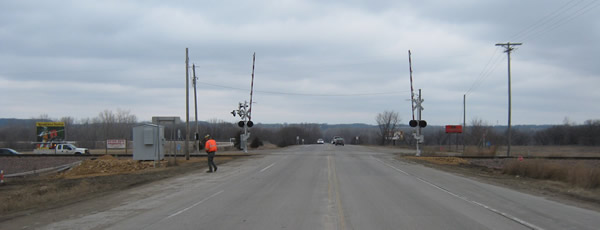
This rail crossing on Hwy 41 near Chaska was recently replaced with new signals, crossing arms and updated technology using funds from the state’s antiquated railroad equipment program. The project was completed in March. Photo by Jim Weatherhead |
Vehicle-train fatalities and crashes at public railroad crossings in 2015 were the second lowest since 1970, according to the Office of Freight and Commercial Vehicle Operations’ rail section.
Four people died at railroads crossings in 2015 in three separate crashes, said Tom Gellerman, rail grade crossing data manager. Thirty-two crashes occurred last year with 19 reported injuries. An additional three people were killed in trespassing incidents. Transit crashes are not included in the numbers.
The number of fatalities has steadily declined since at least 1970, when there were 56 fatalities and 392 crashes. In 2014, nine people were killed and 48 crashes occurred.
“The total number of crashes is far lower than 30 and 40 years ago, but it’s still too high. We must continue to work to make crossings safer and educate the public about the risks at crossings,” said Bill Gardner, OFCVO director.
The decline in Minnesota doesn’t follow the national trend. In 2015, there were 1,780 vehicle-train crashes in the U.S., down slightly from 2014, but about the same from 2012 and 2013. There were 244 fatalities in 2015. An additional 511 people were killed in trespassing incidents.
Each year, MnDOT improves safety at grade crossings by installing or upgrading 25 to 30 active warning devices, spending $20 to $30 million annually.
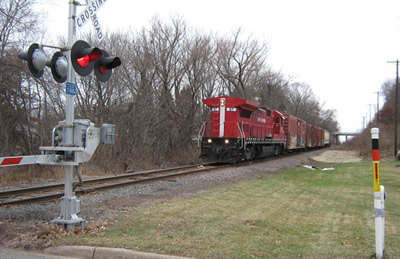
This rail crossing in New Brighton was upgraded with new LED flashers in December 2015. The state-funded Grade Crossing Safety Account financed the project. Photo by Jim Weatherhead |
There are 4,030 public crossings in the state and 38 percent of them have some form of signalized crossing. The other crossings have devices, such as stop or yield signs and crossbucks.
MnDOT administers the Railroad-Highway Grade Crossing Safety Improvement Program to work with the state’s counties, cities, townships and railroads to install and replace signals, improve sight conditions and improve roadway geometrics and grades.
MnDOT also works with Minnesota Operation Lifesaver, an organization that educates the public about making safe decisions around tracks and trains.
Tim Spencer, Rail Planning and Program Development supervisor, said one-third to one-half of the crashes still happen at crossings equipped with active warning devices, making MnDOT’s work and educating the public about the risks important to the effort to bring the number of preventable tragedies to zero.
Motorists should follow these precautions at all railroad crossings:
- Only cross railroad tracks at a designated crossing.
- Whenever approaching railroad tracks slow down and be prepared to stop for an approaching train.
- Always look for a second train before crossing railroad tracks.
- Never use railroad tracks as a trail for hiking, snowmobiling or other recreation.
- Anytime you see tracks, think train.
|
 |
|

|
 |
TABLE of CONTENTS
 |
MnDOT continuously seeks solutions to balance maintenance, environment needs |
|
By Judy Jacobs
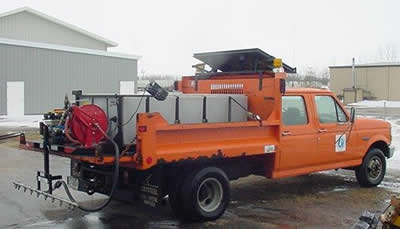
The tank on this MnDOT truck holds salt brine that snowplow operators will apply ahead of a storm. The agency reduced salt brine usage from 2.7 million gallons in 2013-14 to 2.2 million gallons in 2014-15. Photo courtesy of Office of Maintenance |
In 1996 MnDOT’s Office of Maintenance recognized a need to assist snowplow operators in applying the right material in the right amount at the right place at the right time. These four R’s became the ultimate goal of the Salt Solutions program.
Fast forward 20 years. The focus of the Salt Solution program today has expanded to include anti-icing, calibration, environmental concerns, innovative technology, Maintenance Decision Support System/Automated Vehicle Locations and various application methods. The program empowers snowplow operators to make informed decisions about winter material applications by using on-board temperature sensors, sander control systems, Road Weather Information System forecast data, MDSS recommendations and application rate guidelines.
“The MnDOT Salt Solutions Program has been an important part of our winter maintenance operations,” said Sue Mulvihill, deputy commissioner and chief engineer. “The program has been very successful in keeping employees involved in winter maintenance and on-the-job problem-solving.”
Mulvihill said that MnDOT is facing continued pressure from the public to maintain roads during the worst possible conditions and to do it in a cost effective manner.
“Protecting the environment is also a great concern,” she said.
MnDOT’s 2014-15 Winter Maintenance Report shows that the agency reduced salt usage to almost 174,000 tons from 2013-14’s total of nearly 276,000 tons. MnDOT also reduced salt brine usage from 2.7 million gallons in 2013-14 to 2.2 million gallons in 2014-15.
“Whether the state gets a lot of snow and ice in a season, or smaller amounts, resources are still expended to keep roads clear, pay wages and maintain equipment,” said Sue Lodahl, assistant state maintenance engineer. “Variation in salt usage from district to district is based on the severity of the winter, road classifications, level of service, storm patterns and physical environment. Just because we’re not using salt in one area doesn’t mean that we’re not using it in another area.”
A 2013 study conducted by Clear Roads, a national research consortium, found that MnDOT had a five-year average of 212,000 tons of salt used. In comparison, Wisconsin’s salt usage during that same period averaged 512,000 tons.
“Our plow operators and the Salt Solutions Program staff are very dedicated to continuously improving snow and ice operations, which also benefits the environment,” said Tara Carson, water quality educator, Office of Environmental Stewardship. “There is a lot of buzz in the media about organics like molasses, cheese curd brine, and beet by-products. While they may offer side benefits of helping salt stay put or making it easier to see product on the road, we have to remember that they are not actual de-icers. Unfortunately, they also deplete oxygen as they break down, which is harmful to aquatic life.
“There’s no silver bullet. Everything we use will have some effect. It’s a privilege, not a right, to use salt. We can’t ignore that,” she said.
Carson noted, although MnDOT works to right-size its salt usage, it’s “only a piece of the puzzle.”
“I am pleased to hear MPCA acknowledge that part of the solution is to educate and encourage private applicators and homeowners to use salt responsibly. Chlorides are a complicated issue and Minnesotans need to realize there are consequences for having such high expectations for winter driving conditions,” she said.
“I’ve met many of our snowplow operators and I am always impressed with their commitment to keeping our motorists safe. They live, work and raise their families in the area so they have a vested interest in protecting the environment,” Mulvihill said. “MnDOT will continue to be an advocate for the four R’s to reduce excess material being used during snow and ice operations. With every new piece of information and technology we will strive to improve the way we do business.” |
 |
|

|
 |
TABLE of CONTENTS
 |
Annual conference highlights innovations in transportation |

Lt. Gov. Tina Smith kicked off the 2016 Minnesota's Transportation Conference. More than 800 transportation professionals attended the three-day event held March 8-10 in St. Paul. Photo by Rich Kemp |
More than 800 people from the transportation industry attended the 2016 Transportation Conference in St. Paul March 8-10.
The event is the only one in the state where every facet of transportation is represented. It featured more than 30 sessions and highlighted the latest innovations in a variety of transportation topics, including the future of transportation. Many MnDOT staff helped plan the conference and served as session presenters and moderators.
This was the third year for the conference. The 2017 conference will also be in St. Paul. Presentation materials will available soon at http://mntransportationconference.org/.
Commissioner Charlie Zelle introduced Lt. Gov. Tina Smith, who kicked off the event March 9. She spoke about the importance of transportation to Minnesota’s economy and the need for long-term funding to address the estimated $6 billion gap that exists between funding needs and estimated revenues in the next 10 years.
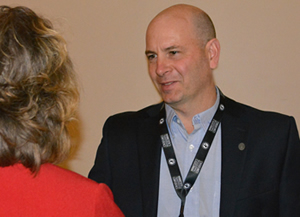
Pat Huston, District 1 project manager, meets with a transportation conference participant after his presentation on Construction Manager/General Contractor at the 2016 Minnesota's Transportation Conference. Photo by Rich Kemp |
Conference participants also heard about "Demographic Change in Minnesota: The Long-Run has become the Short-Run" from Susan Brower, Minnesota state demographer. Gregory Nadeau, Federal Highway Administration administrator, also presented a keynote address on "Beyond Traffic: US DOT's 30-Year Framework for the Future."
In one breakout session, Pat Huston and Andy Johnson, District 1/Duluth, were on a panel that talked about the use of Construction Manager/General Contractor on MnDOT projects. Huston and Johnson are part of the MnDOT team leading the Hwy 53 relocation project in Virginia, Minn. The project is the second in the state to use CM/GC.
|
 |
|

|
 |
TABLE of CONTENTS
 |
What’s new on the web |
Maintenance updates web page
The Office of Maintenance page received two major updates this week:
- Frequently Asked Questions are on the navigation bar at the top right. Here you’ll find MnDOT’s typical snow and ice responses, as well as answers to common questions that elected officials, the media and the general public may ask. Over time, FAQ on other maintenance topics will be added.
- A Technology Transfer web page is now available from the Research page. Everything you wanted to know about the intent of the Technology Transfer initiative – known as T2 – is here, including ideas that maintenance staff submitted from various Minnesota truck stations. If you have questions about the T2 initiative, contact specialist Steve Blaufuss at Steven.Blaufuss@state.mn.us.
New Library Materials
New Library Materials are available at www.mndot.gov/library/newlibmat.html.This issue includes a feature about the diversity/inclusion collection and its recent display at the MnDOT Library.
New Library Materials is a compilation of new titles and other resources added to the library collection during the previous month. If you would like to be added to the distribution list, contact Pam Gonzalez at 651-366-3749.
Previous editions of New Library Materials are available at www.mndot.gov/library/recacq-archive.html.
For other information requests, contact the Library at 651-366-3791 or e-mail library.dot@state.mn.us, or send requests via the Ask a Librarian Web page at www.mndot.gov/library/asklibrarian.html.
|
 |
|

|
 |
TABLE of CONTENTS
 |
Celebrating successes of WIG 1.0 – Enhancing Financial Effectiveness; looking ahead to WIG 2.0 |
By Tracy Hatch, deputy commissioner, chief operating officer and chief financial officer
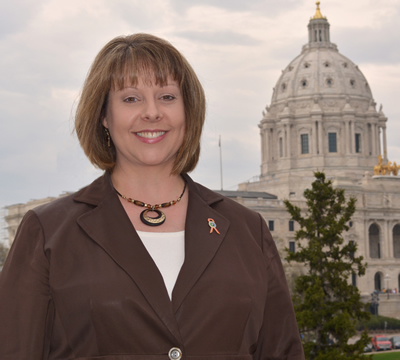
Tracy Hatch, deputy commissioner, chief operating officer and chief financial officer. Photo by Rich Kemp |
This week marks an amazing milestone at MnDOT. Can you believe it has been over two years since we launched ourselves into our first Wildly Important Goal of Enhancing Financial Effectiveness? Over the last two years I’ve had the opportunity to meet with many of you and hear your success stories. It’s absolutely inspirational to learn about the effort and energy you have dedicated to making MnDOT more financially effective.
Many of you worked on Other WIG Supporting Activities, or OWSAs. Employees identified almost 400 OWSAs that have resulted in improved quality of our work, reduced costs and reduced delivery times. One great example is a design change to the salt spinner motors that prolong the life of the device. During the last two years MnDOT has also identified more than $63 million in efficient practices, including innovative ideas such as installing LED lights to replace older bulbs, using the tow plow in snow and ice operations.
March 14–18 has been set aside to recognize and celebrate the work you have done. Each employee will receive a thank you card and a highlighter to “Highlight Our Success” of WIG 1.0. Each manager and supervisor will receive a copy of the WIG Enhancing Financial Effectiveness final report. The report provides the background for MnDOT’s initiation of EFE and how we have used the 4 Disciplines of Execution (4DX) method to make progress on our Wildly Important Goal of Enhancing Financial Effectiveness. It highlights the accomplishments of the four battle projects (Financial Management, Asset Management, Project Management, and Information & Outreach) and Other WIG Supporting Activities. Please take a few minutes to review it.
I’d like to personally thank you for your efforts and to update you about our next steps. No, we’re not done yet. We want to ensure that the gains made during the first WIG are not lost as we pass this important milestone. We need to integrate these new practices into the “whirlwind” of our everyday work lives. To accomplish this, we need to do some very deliberate planning.
The senior leadership team has been strategically planning what we, as an organization, will do next. We do know that whatever we do will build on what we have learned through our first WIG effort.
We have selected and begun training 4DX coaches to support our future efforts of 4DX statewide. Each MnDOT office and district has 4DX coaches ready and happy to help you with any questions you may have. Click on this link to local coaches to find out who your coach is.
Over the next few weeks you will be joining in conversations with your coworkers to help define and shape our future course. In an effort to help us develop WIG 2.0, these WIG 2.0 Development Assignments will lead your team through a series of questions to document who your customers are, what they want and how we can measure and improve customer outcomes. Your input is important and highly valued. We will evaluate and consider all feedback to continue the momentum and help us shape WIG 2.0. Thank you in advance for your work on this important piece of shaping our future.
Thank you for all your contributions towards enhancing MnDOT’s financial effectiveness and for the work you do every day to make MnDOT the great agency that it is. It is a pleasure to serve Minnesota alongside each of you!
Resource Investment Council to provide funding for “Best of the OWSAs”
The “Best of the OWSAs” program will be launching soon to recognize the efforts and innovations achieved under MnDOT’s Other WIG Supporting Activities. MnDOT’s Resource Investment Council listened to employee feedback in the EFE All Employee Survey, and created a program to recognize the best OWSA projects. The work areas of the selected OWSAs will receive funding for equipment or resources to make their work more efficient. All OWSAs that have been reported to date will automatically be considered candidates for the Best of the OWSAs.
|
|
 |
|
| |
|



